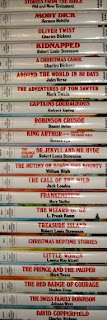Book Review: Black Beauty
“If a thing is right it can be done, and if it is wrong it can be done without; and a good man will find a way.”
When I was a child, my brother, Sam, had a million and one of these abridgements. They looked like this:
I don't actually know what happened to these books. But there were bajillions of them that just lived on Sam's shelf. When I learned to read (and he was kind of grown out of them anyways), I started reading them en masse. Part of this was that there was Book Bingo at school, and you got to mark off the genre of book on your bingo board for finishing it, whether or not it was on your level, short, long or whatever. So, the majority of these, I probably could have read the real version, but I didn't. It would have taken me longer, and I might not have won Book Bingo.
It occurred to me not long ago that I should reread all the ones that I never got around to reading the real version. I'm not going to say that I never read the real version of any of them, but there are a lot of them that I have not actually read the classic version. One of those is Black Beauty.
When I was seven, or whatever I was when I read the abridgement, I thought it was one of the best books ever to grace the planet. I read the real version, and I'm not really sure what it was that lead me to that assumption.
Disclaimer: I made a tongue-in-cheek comment about how Black Beauty is actually called Black Beauty: The Autobiography of a Horse, and that the book is about as riveting as the title sounds. One of my friends mentioned that she felt that Black Beauty is a great commentary on the era, and that it really analyzes the question of kindness. She is right in some ways. I did think it was rather clever how the author, Anna Sewell, managed to comment on most every level of society of 1880s-or-so England through the eyes of a horse, and it is true that kindness plays a central role in the book.
However, I couldn't help feeling that I was reading PETAs 200-page mission statement. It seemed like an entire book of animal activism. Now, I don't think we need to be cruel to animals. God gave us stewardship over animals, and anyone who actually understands the meaning of the word stewardship knows that that means that you have a sacred and solemn responsibility to treat them with the kindness that something weaker than you and under you deserve. As Sirius Black said in Harry Potter and the Goblet of Fire (and could have benefited by listening to), “If you want to know what a man's like, take a good look at how he treats his inferiors, not his equals.” And yet, I've never made much secret about the fact that, other than frogs and hamsters, I would be quite content for animals to live happy, but away from me. I'm not an animal lover. And as much as I believe it's important to be nice to animals, I don't know if I want a 200-page lecture about it. Checkreins are evil. I get it. I've never even seen one, let alone used one.
There are also images that haunt children's childhoods and they then carry them into adulthood. For me, one of these images is image of Elizabeth Bathory stringing up virgins in the dungeons and then bathing in their blood. Another one is from the fairy tale that got turned into the popular book, The Goose Girl. In the end, the villain is put into a barrel that is studded with nails and then dragged from behind a horse. I also remember this still, artistic rendering on the History Channel of William Wallace being drawn and quartered. From what I hear, the image of the body of the other horse, Ginger, being carted away with her tongue and head lolling out is one of those images for many people.
It is a clever idea. However, I just felt like the soapboxing was too much. Also, it was a slow-mover. Let's be honest, the lives of horses are slow-moving. Though I understand others liking the book, I just can't get behind it. 2 stars.




Comments